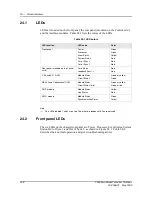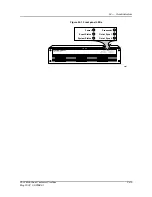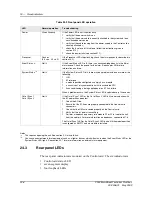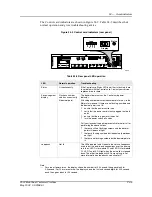
23 — Cross-connecting circuits
23-2
2902 MainStreet Technical Practices
90-2906-01 May
2002
23.1
Types of cross-connections
Cross-connections can be basic or specialized. Basic cross-connections include the
following types:
•
simple
•
super-rate
•
protecting
Specialized cross-connections are used for the following applications:
•
multidrop data bridge connections (see section 17.10)
•
CPSS channel connections (see section 14.2)
23.2
Simple connections
A simple connection is a connection between one primary rate circuit and one data
circuit, or between two primary rate circuits on different primary rate modules.
Simple connections are used for drop and insert as well as bypass applications
(described below). They are not used for super-rate connections (see section 23.3) or
protecting connections (see section 23.5).
You cannot cross-connect a data circuit to a primary rate circuit and then
cross-connect that primary rate circuit to another primary rate circuit.
If you try to cross-connect a circuit that is already connected, a warning appears on
the screen. If you proceed, the new connection is made and any existing connections
involving the two original circuits are broken.
When connecting a primary rate circuit to an endpoint circuit, the signaling types for
both circuits must match. If the primary rate circuit is configured with its default
signaling type, it automatically adopts the signaling type required by the endpoint
circuit (until the circuit is disconnected). If the primary rate circuit is configured with
a specific signaling type, the connection is not allowed unless the signaling types for
both circuits are the same.
Drop and insert configuration
A drop and insert configuration uses three nodes connected in tandem, with the drop
and insert node in the middle (see Figure 23-1, Node B). The drop and insert node
cross-connects both through traffic and drop and insert traffic.
In Figure 23-1, through traffic flows from Node A, through Node B, to Node C, using
cross-connections between primary rate circuits on modules P1 and P2.
Note —
Before a circuit can be cross-connected, its module position
and circuit parameters must be configured. For information on
module position and circuit configuration, see chapter 12.
Summary of Contents for MainStreet 2902
Page 1: ...2902 MainStreet Network Termination Unit Release 1 0 H T E C H N I C A L P R A C T I C E S ...
Page 40: ...3 Mounting the unit 3 8 2902 MainStreet Technical Practices 90 2906 01 May 2002 ...
Page 50: ...4 Ground and power connections 4 10 2902 MainStreet Technical Practices 90 2906 01 May 2002 ...
Page 68: ...6 Connecting to the network 6 4 2902 MainStreet Technical Practices 90 2906 01 May 2002 ...
Page 90: ...7 Connecting to data devices 7 22 2902 MainStreet Technical Practices 90 2906 01 May 2002 ...
Page 108: ...10 Node management 10 10 2902 MainStreet Technical Practices 90 2906 01 May 2002 ...
Page 150: ...14 CPSS 14 6 2902 MainStreet Technical Practices 90 2906 01 May 2002 ...
Page 218: ...20 Codirectional DCM 20 6 2902 MainStreet Technical Practices 90 2906 01 May 2002 ...
Page 234: ...22 HCM rate adaption 22 10 2902 MainStreet Technical Practices 90 2906 01 May 2002 ...
Page 246: ...23 Cross connecting circuits 23 12 2902 MainStreet Technical Practices 90 2906 01 May 2002 ...
Page 254: ...24 Visual indicators 24 8 2902 MainStreet Technical Practices 90 2906 01 May 2002 ...
Page 266: ...25 Alarms 25 12 2902 MainStreet Technical Practices 90 2906 01 May 2002 ...
Page 278: ...26 System diagnostics 26 12 2902 MainStreet Technical Practices 90 2906 01 May 2002 ...
Page 298: ...27 Loopbacks 27 20 2902 MainStreet Technical Practices 90 2906 01 May 2002 ...
Page 332: ...Glossary GL 8 2902 MainStreet Technical Practices 90 2906 01 May 2002 ...
Page 343: ......
Page 344: ... 2002 Alcatel All rights reserved 90 2906 01 95 1820 01 00 C ...
















































